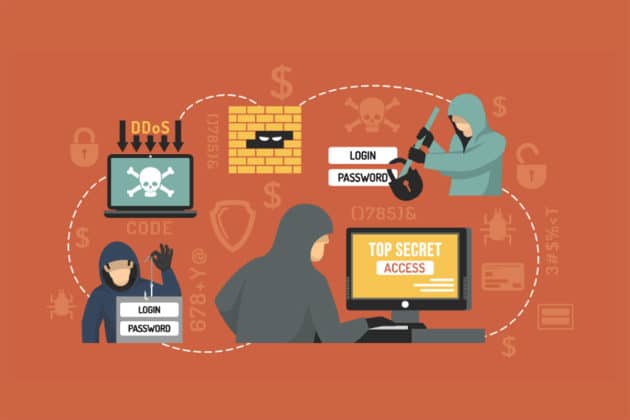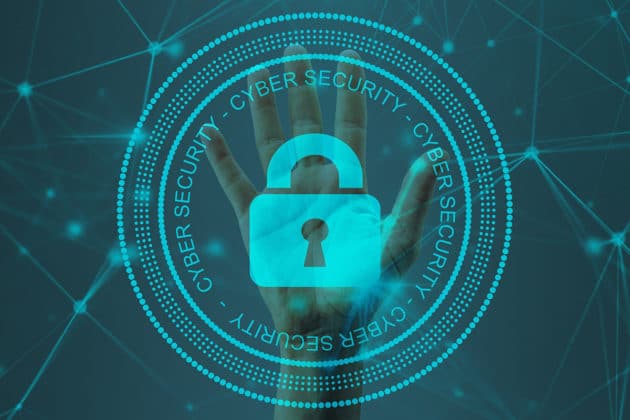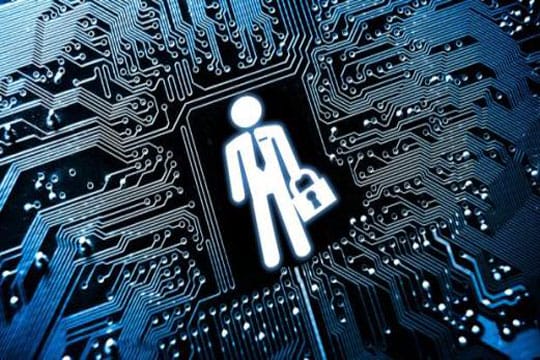Just like a big corporate organization, small businesses are equally exposed to malware from hackers at any time. The data held by small businesses is by no means of any lesser value than that collected by major organizations for business growth and operations. The value of the data and laxity in their cyber security measures constantly exposes the business to hackers.
A survey conducted by SBA showed that 88% of owners of small businesses believed it was just a matter of time before they became victims of a cyber-attack. The problem is that these businesses fail to invest sufficient resources in their IT departments. And others simply do not know how to address the challenge.
Small businesses seek ways to strengthen their defense mechanisms to keep their business safe online by constantly learning new ways of countering current and emerging threats from cyberspace.
The frequent types of cyber-attacks on small enterprises

Let’s know about some most common types of cyber-attacks that your small business can face. You have to find a solution to keep your business safe online from these cyber-attacks.
Recommended for you: How to Protect Your PC from Cyber-attacks, Tracking, & Malware?
1. Social engineering fraud
The objective of this type of attack is to manipulate organizations to give up confidential data like passwords, social security numbers, or credit card information. Often, social engineering fraud is perpetrated by phishing emails to send false payments or data requests that seem to originate from legitimate sources.
For instance, a small business searching for new vendors or networks to plan daily operations may fall victim to social engineering fraud. Always make sure you confirm the authenticity of every organization before clicking on any links, filling out online data forms, or replying to emails.
2. Impact of working from home
Most small businesses prefer to allow some or all of their staff to work from home whenever possible. This operational strategy may have tremendous cost-saving benefits but puts the business in danger of cyber security attacks. Even when different staff members have to work remotely and from separate locations, the organization must remain careful to nullify all cyber-attacks in their infancy.
3. Malware attacks
Malware is commonly defined as software, viruses, or ransomware designed to disrupt and destroy the computer or network connectivity or to allow intruders to obtain confidential information. Most people tend to associate ransomware with large organizations only. However, you will be surprised to learn that between 50% and 70% of ransomware affects small and medium-sized enterprises. This is partly the reason why most of these businesses collapse within the initial six months of operations.
Cases of recent cyber-attacks

Learning about the modern-day nature of cyber-attacks, i.e., the definition of a cyber-attack and its negative impact can help to keep your business safe from all forms of online cyber threats.
A security breach at Capital One Corporation
Capital One, a financial services company, discovered its systems had been hacked in July 2019. The criminals managed to get their hands on personal data belonging to customers of small businesses who were seeking credit card services with the corporation. Security analysts estimated the data heist affected about 100 million people (external link) in the U.S and another six million in Canada.
The Weather Channel’s ransomware
This attack occurred in April 2019 and was aimed at the Weather Channel. Following the attack, the television network was compromised by a malicious software attack (external link) at 6 a.m., just about when it was about to go live. After about two hours, normal service operations were restored using a backup system. The turnaround strategy worked because the TV’s cyber security preparedness was on high alert.
Cyber-attack on U.S. Customs and Border Protection Perceptics
This attack happened in June 2019. The U.S. Customs and Border Protection (CBP) confirmed that pictures of faces and license plates had been stolen. This attack mainly affected the company’s network of subcontractors, Perceptics. It is estimated that the attackers made away with about 100,000 images of individuals taken at one land border point of entry.
Citrix cyber security breach
In March 2019, the FBI learned that hackers had already accessed and stolen a large quantity of sensitive data. They hired Citrix, a software company to take care of the situation. Investigations showed that the cyber-criminal group relied on a series of techniques like “password spraying” to gain access to emails, files, and important business files.
In Texas, ransomware attacks
This attack took place in August 2019. It was around this time when it became known that organizations working with the local governments of 23 towns and minor cities in Texas had been attacked by an organized group of cyber attackers. The attackers stopped the flow of government services in the small municipalities while they demanded a ransom.
What are the best strategies for enhancing cyber security for small businesses?

“Small organizations often don’t have the resource, cash, or expertise to manually investigate this flood of alerts of cyber security. At the other end of the spectrum, it very quickly becomes unscalable for larger enterprises. They may have dedicated security teams and larger security budgets. But they are running dozens of these single-point solutions.” – as explained by David Atkinson in one of his published articles. David is a cyber security specialist who is the founder and CEO of SenseOn.
Let’s discuss some most proven strategies that you can implement to enhance the cyber security of your organization to keep your business safe online.
Education
There is a need to continually educate your staff on new ways of handling emerging cyber threats. This is because cybercriminals are perfecting their trade every day. If your staff knows how to improve their cyber security protocols, then your business will be much safer.
You may need to send your employees constant reminders to avoid opening files or following links from unfamiliar sources. Also, consider providing your employees with the processes for encrypting personal or sensitive data and training them on how to confirm the authenticity of random requests for payment.
You may like: 7 Ways How Human Error Can Cause Cybersecurity Breaches.
Safe practices on working devices
Most cyber-attacks occur as a result of weak, compromised, or lost passwords. In the modern world, where most people prefer working with their individual devices, it is paramount that all networks and passwords are protected and stored safely. Another way is to compel your staff to change their passwords every 60 or 90 days.
Ensure your business works with trustworthy platforms and partners
The strength of your cyber security systems is dependent on the reliability of platforms and partners used by your business. See the information below:
- Consider using a Web Application Firewall (WAF) to safeguard your site.
- Ensure the payment card industry – Data Security Standards (PCI-DSS) of your e-commerce platform complies with Level 1. That way, your business is protected from digital data security breaches likely to affect the whole payment system, not just a single card.
- Dedicate staff members in your organization to repeatedly patching security weaknesses to lower the probability of cyber-attacks.
- Confirm every computer in your business organization has active antivirus software. Antivirus is crucial even when your staff is well trained on how to identify a phishing email.

Safeguard your company’s hardware devices
Sometimes, theft of physical company assets can be the cause of data loss. This is why you have to take extra measures to protect your servers, cell phones, laptops, and other gadgets from theft. You might need to install security cameras and alarms in your business or consider physically locking down the computers and servers to keep them in place. Regardless of where your staff is working from, whether at home, in the office, or at shared workstations, ensure they know the importance of keeping company equipment safe.
Raise the security level of your email system
According to Symantec’s report from 2019 on the Internet Security Threat Report, almost half of the malicious email attachments originate from office files.
There is a need for your employees to take the necessary precautions, like avoiding opening suspicious emails or links. These lessons could be included in the employee training scheme. Simultaneously, documents containing clients’ private data must be encrypted from end-to-end, such that the recipient uses a password to open the document.
Reinforce data
Regardless of the precautionary measures, you take to protect your business from cyber-attack, you can never be too sure of success. Therefore, we advise that you reinforce the following vital information:
- Company databases.
- Financial documents.
- Human resource documents.
- Documents showing the company’s accounts receivable or payable.
Ensure you back up all your business’s stored information on an online storage drive and repeatedly confirm that your system is working properly.

Developing a holistic plan
A holistic security plan needs to incorporate a staff-training program and an appropriate response plan to cyber threats. The initial step of safeguarding your business’s network is to ensure your staff members know all the security policies and processes.
Employee training needs to be carried out frequently. For example, it can be done annually or semi-annually to provide employees with actual lessons and refresher courses to maintain a sturdy cyber security system. In addition, you must guide your employees to master the need to update their software, meet the required security obligations, and understand what needs to be done to detect and deal with a potential security breach.
The quicker you respond to a cyber-attack, the easier it will be to deal with moderate potential damage.
The ideal response plan needs to have important information like:
- The person to be contacted.
- The storage location of the organization’s data and data backups.
- When to call law enforcement or the public to notify them about the breach.
The Federal Communications Commission provides owners of small businesses with a cyber planner to assist in developing a cyber security plan for the business. You can produce a customized cyber security plan below the page after you have finished creating it.
Safeguard your Wi-Fi connection
At the time of purchase, the Wi-Fi network equipment was not secure. The device usually has a default password, but it is always advisable to encrypt the device with your own special password. The router should allow you to select the type of password security level to use; we suggest using the most secure Wi-Fi Protected Access II (WPA2) code.
Simultaneously, you must keep your network hidden to ensure the router does not broadcast the name of your network. To grant access to customers access to the Wi-Fi, it is best to set up a “guest” account that uses a separate password and different security settings to keep them away from the main network.
Protect your payment systems
To protect your business payment processors, liaise with your banking institution to ensure the system’s software is updated. Please note that complex payment systems are more difficult to secure. However, the Payment Card Industry Security Standards Council provides the guidelines to assist you in determining the system to use and how to safeguard it.
You may also like: 17 Cool Tips for Writing a Cybersecurity Policy that Doesn’t Suck.
How to report a cybercrime incident?

Regrettably, cyber-attacks on small businesses are a frequent occurrence. Therefore, victims of cyber-attacks need to know the right steps to follow when handling cybercrime cases.
In the UK, all cases of cybercrime are reported to Action Fraud (external link). Action Fraud then forwards the case to the National Fraud Intelligence Bureau and gives a police crime reference number.
In case your business’ finances have been put at risk, ensure you contact your bank as soon as possible to thwart any attempts on your bank account and to begin investigations into the fraud. In addition, call your insurer and immediately seek the necessary help if your business has cyber insurance.
Cases, where business information is stolen or compromised, are likely to breach GDPR. Therefore, such incidents need to be reported to the ICO before the lapse of 72 hours to reduce potential penalties.
Both large and small businesses have a lot to benefit from solid cyber security plans. Ensuring you enforce information security processes and installing dependable antivirus and antispyware software is the best way to prevent cybercrime attacks on your business.
It will also help to include cyber insurance in the insurance policy of your small business. In the event of a cyber-attack, the insurance cover will assist in reducing the cost of data recovery, system repair, reputation management, and legal defense.





